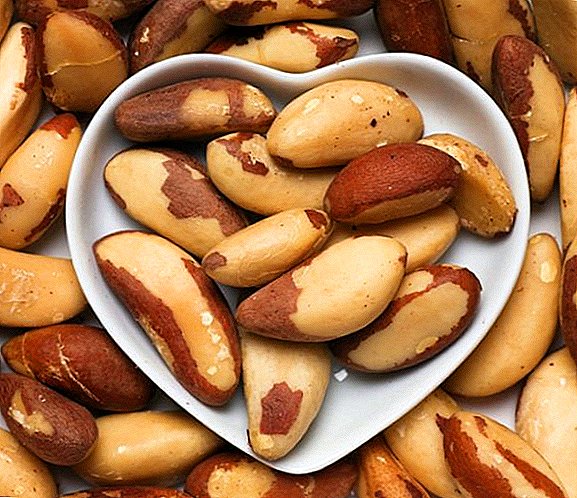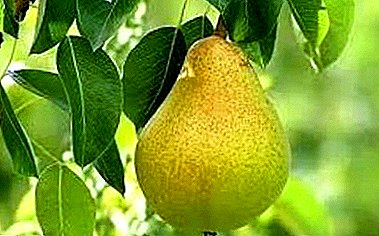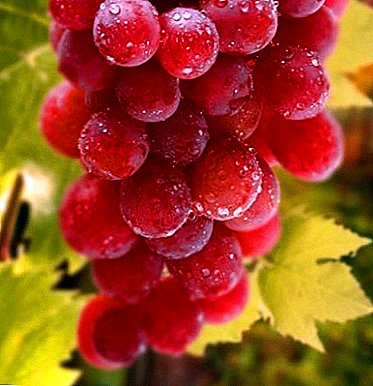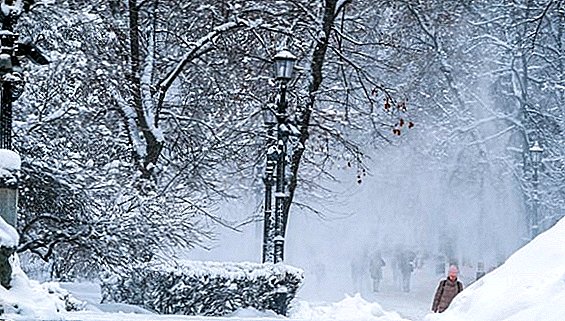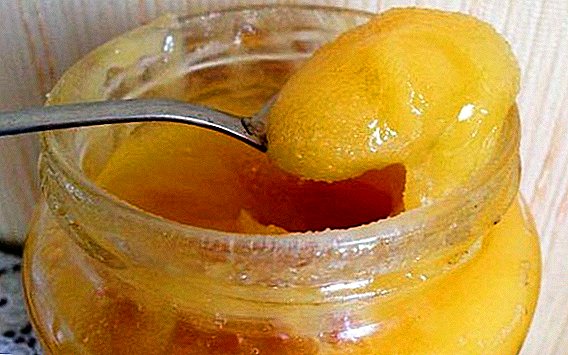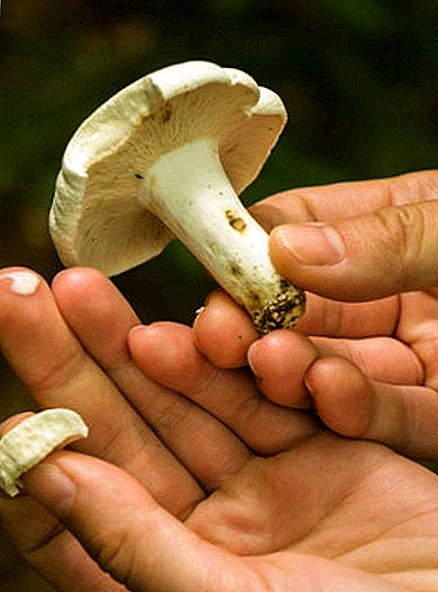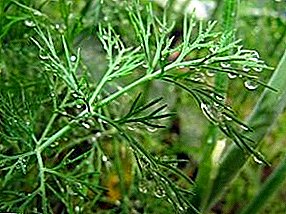
The fast-growing shade-tolerant vine clings to the ground and climbs up tree trunks in the humid warm thickets from the tropics of India to the northern areas of Australia.
The botanical names of this plant of the aroid family are quite diverse: in different periods, the representatives of the species were called “Rafidophora”, “Scinapsus”, “Potosom”, “Epipremnum”.
However, in the practice of indoor plant growing graceful vine often referred to as "Scapse".
Plant species
"Money Cluster"
He also “Epipremnum Golden” or “Golden Potos” at home can grow stalks up to 5 meters long. Its bright green leaves are decorated with yellowish strokes and stripes.
The photo shows the flower “Gold leaves” (Potos) with proper care at home:

"Painted Paints"
It has dark green foliage, dotted with light silver spots and splashes. It doesn’t differ from the “Golden Color” at home care.
The photo shows the Painted Flower (Potos) with proper care at home:

Home care
Is it possible to keep Scandapsus at home (Potos)?
Attention! The leaves and stalks of Scinspusus are poisonous, like all members of the aroid family.
Therefore, the vine should not be placed where it can get pets and small children.
 In addition, there is a belief of obscure origin, attributing this plant to the category of "muzhegonov", as if surviving from the house of the representatives of the stronger sex.
In addition, there is a belief of obscure origin, attributing this plant to the category of "muzhegonov", as if surviving from the house of the representatives of the stronger sex.
In fact, of course, men, if they are going to leave, do it for reasons much more solid than a vine in a pot.
"Money banks", meanwhile, grow beautifully in shady corners, rise on vertical supports, willingly branch, forming lush ampelous garlands, and easily propagate vegetatively.
The video contains a general description of Scandapsus creeper (Potos) and home care recommendations:
Lighting
This vine does not even belong to shade-tolerant, but to shade-loving plants. The most suitable for her lighting give windows of the north.
"Money banks" can do without the sun at all - they need a white light lampoperating 12 hours a day. True, with a lack of lighting, the variegation of leaves disappears - the picturesque stripes and spots replace an even green color.
Temperature
Temperature optimum for spring and summer - from 22 to 24ºСIn winter, the temperature can drop to 16-18 degrees.
The plant should be protected from drafts and temperature drops.
Attention! A sharp drop in temperature to + 12ºС is critically dangerous.
Container and soil
 The root system of vines develops more in breadth than deepertherefore, a low capacity is chosen for it.
The root system of vines develops more in breadth than deepertherefore, a low capacity is chosen for it.
It can be quite broad to plant cuttings to the mother plant and form a lush growth of young shoots.
In order to prevent the stagnation of moisture, which is destructive for “Scrippsus”, the bottom must have a drainage hole.
The plant needs a neutral or slightly acidic, fairly fertile and loose soil.
Suitable universal purchased soil with the addition of perlite or one of the mixtures:
- three parts of sod land with one part of leaf and the same amount of sand;
- equal amounts of leafy ground, peat, humus and sand, additionally loosened with perlite.
Planting and transplanting
At the bottom of the pot should be sure to lay a drainage layer of small stones, expanded clay or ceramic fight. Then pour a layer of prepared soil, place straightened creeper roots on top of it and, from time to time, compact it and fill it with an earthen mixture. Water the planted plant.
The frequency of transplantation depends on the age of the vine. Young "Safety Deals" are transplanted annually in the spring. Mature specimens in a year or two.
Watering and humidity
Excessive moisture in the soil is especially harmful to this plant.
Therefore, regular watering with distilled water at room temperature is carried out over the dried top layer of the soil, and the moisture accumulated in the pan drains.
The average frequency of watering in spring and summer is from two to three times a week, in winter - once or twice a week.
Tropical lianas need high humidity, which is provided by spraying with soft water 1-2 times a day, as well as placing the container with the plant on a pallet with wet pebbles or expanded clay.
Top dressing
Scandapsus, which is intensively developing in the spring-summer period, needs fertilizing with a liquid mineral complex every two to three weeks.
In winter, large plants with long stems should also be fed once a month.
Pruning
 At home, the growth rate of the stems of this vine reaches a meter per year, and without forming pruning it quickly becomes small any vertical support.
At home, the growth rate of the stems of this vine reaches a meter per year, and without forming pruning it quickly becomes small any vertical support.
The pinching and pruning of shoots in the spring and summer period stimulates branching, due to which the “Scandapsus” becomes an attractive ampel bush or forms dense leafy “walls” of the desired size.
Waste after pruning can be used for vegetative propagation.
Breeding
In the practice of home plant growing, "Scinduses" are propagated exclusively by vegetatively - apical and stem cuttings.
Cut off the tops of the shoots with two or three leaves or prepare parts of the stem with the same number of leaves. Apply preliminary water rooting or immediately planted cuttings in a mixture of equal amounts of sand and peat.
Cover the planting with transparent polyethylene, ventilate, spray, maintain the moisture content of the soil substrate and contain at a temperature of 20-22ºС. The root system of seedlings develops within two to three weeks.
Application
In room culture, Scinduses are irreplaceable gardeners of dimly lit rooms.
Their intensive growth can be directed by vertical supports and form a target pruning, getting unpretentious and viable ampelous plants.
Interesting! These vines actively absorb volatile formaldehyde compounds, cleaning the air from harmful impurities.
Possible problems and solutions
Yellow and fall leaves, the stems rot with an excess of moisture in the soil, especially in winter, in combination with a low temperature. It is required to optimize the temperature and humidity conditions.
The tips of the leaves are tuckedbecome brown with insufficient air humidity. The plant needs regular spraying.
Sluggish folded leaves, areas of rotting on the stems - a consequence of the content at a temperature of 12 degrees and below. Scindupsus needs a warmer room ...
Yellowing or falling leaves causes insufficient feeding, a sharp decrease in illumination, drafts. It is necessary to optimize the conditions of maintenance and feed the plant.
Brown spots on leaves and on the edges of the leaf plates occur when there is insufficient watering during the growth period. The soil should not be overmoistened, but at the same time, its overdrying is unacceptable.
Color fading, replacement of green areas with light, “burnt out” occurs under excessive sunshine. It is necessary to rearrange the plant in a more shady place.
Small leaves, losing diversity, elongated shoots develop with a lack of light. Even a shade-loving "Scrippsus" needs lighting of the necessary intensity and duration. Requires permutation or lighting up.
Diseases and pests
 Under optimal conditions, the plant is practically not affected by disease.
Under optimal conditions, the plant is practically not affected by disease.
Low temperatures in combination with high humidity provoke the development of stem and root rot.
If these processes have gone far, you need to prepare cuttings from healthy parts of the vine and root them.
It is necessary to get rid of the rest of the plant and the soil, and then carefully disinfect the empty pot.
Wreckers settling on “Cinches” - scale insects, spider mites, aphids and thrips.
As a first measure, insects are removed with a cotton swab dipped in alcohol and the plant is treated with a soap solution.
However, only systemic insecticides used according to the instructions are finally destroyed by pests.
“Crystallsus” (Potos) is an unpretentious houseplant that can grow intensively in low light conditions and at the same time absorb harmful volatile impurities from the air. Simple care and regular pruning from the tropical liana form ornamental deciduous ampelous bushes or "rugs" of vertical gardening.


